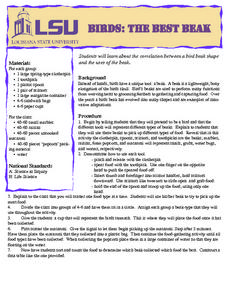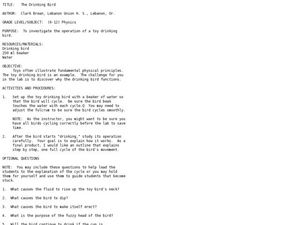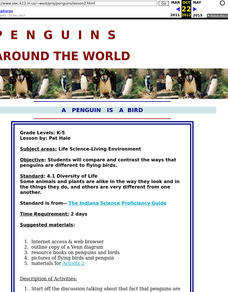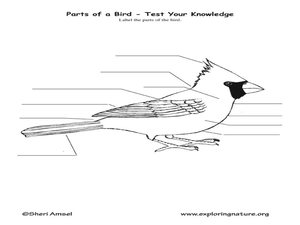Curated OER
Birds: The Best Beak
Learners examine the correlation between a bird beak shape
and the uses of the beak.
Curated OER
Amazing Bird Adaptions--Why Am I A Bird?
Fourth graders identify and classify birds found in Illinois. Using the internet, they discover how birds have adapted over time and how the adaptations have increased their life span. They compare and contrast the various adaptations...
Curated OER
Marine & Aquatic Habitats Activities - Estuaries Are for the Birds!
Students recognize that birds act as indicators of pollution because of their sensitivity to environmental change, and role play the manner in which marine debris can be hazardous to waterfowl.
Curated OER
Birds of Wisconsin
First graders explore the job done by ornithologists. They role play identifying the characteristics that make a bird a bird. They discuss what makes each bird species unique. Students are introduced to Wisconsin's most common and rare...
Curated OER
Connect the Dots: Birds of Prey
For this science worksheet, 2nd graders will connect the dots to create an image of a bird. Students will connect the numbers from one to thirty-four.
Curated OER
Bird Land
Young scholars role-playing the concept of evolution through naturally occurring mutations. Working in pairs, they model how birds have adapted to the food sources in their environment through changes in their beak size and shapes....
Curated OER
Beans, Beaks and Bears
Students explore evolution. After watching a video on evolution, students perform a variety of experiments using beans which illustrate the concept of evolution.
Curated OER
Compare Human-made Objects with Natural Objects
Students examine and observe how many human-made objects get their basic design from things in nature. They listen to the book "Nature Got There First," compare/contrast hollow bones with drinking straws, bird beaks and tool pliers, and...
Curated OER
Watch the Birdie
Students complete a six-week unit on North American birds. They conduct research, develop fact sheets, create labeled bird drawings, write a dictionary of bird vocabulary words, create a Concentration game, and observe birds in their...
Curated OER
The Drinking Bird
Students discover how the "drinking bird" functions. In this investigative lesson, students discover what makes the drinking bird drink by analyzing relative humidity, temperature, and barometric pressure.
Curated OER
The Drinking Bird
Students discover how toys often illustrate fundamental physical principles. The toy drinking bird is an example. The challenge for you in the lab is to discover why the drinking bird functions.
Curated OER
Flocking to Food
Students observe shore birds feeding. In this shore birds lesson, students visit a beach and observe shore birds feeding. Students discuss shore birds feeding behaviors.
Curated OER
A Penguin is a Bird
Students compare and contrast the ways that penguins are different to flying birds.
Curated OER
Study Of Birds
Learners investigate the Spanish language looking for words related to birds and their habitat. They write phrases and sentences using the words. Gradually they attempt to use the correct sentence structure in conjunction with reading...
Curated OER
Learning Bird Traits
Students draw and label a bird. In this bird traits lesson, students learn what traits make a bird different from other animals. Students are taught how to draw a bird and are expected to label the various body parts they drew.
ARKive
Biodiversity and Evolution – Darwin’s Finches
Teens experience natural selection firsthand (or first beak) in an activity that has them act as finches foraging for food. Using different household items to act as different beak styles, your little finches will collect as much food...
Field Museum
The Case of Darwin's Finches
One of the most striking pieces of evidence for Darwin's Evolution of Species was his observations of finches and how their beaks differed from island to island, depending on their primary food sources. So what would happen to the theory...
Scholastic
Awesome Adaptations
Engaged learners discover how an owl beak works and how animals adapt to their environment. This task is part one of a three-part series.
Polar Trec
Swan Savvy
Just like so many other birds, swans migrate during the cold winter months. Your class can gain a better understanding of migration and bird life as they act out some of the activities common to the tundra swan. They make a nest, sit on...
Curated OER
Eeks Beaks
Seventh graders examine the concept of adaptations that take place in the wild. Birds are the focus organism for this study. They examine the beaks of different birds and point out the differentiations.
Curated OER
What Is A Raptor?
Students examine the special characteristics of raptors and discover what separates them from other birds. Students look at different photographs from the Internet or magazines of several different birds and identify the raptors based on...
Curated OER
Desert Animals
Students are asked if they think a roadrunner is a bird that is a fast runner or a slow runner? They are given a copy of Roadrunner Display Sheet. Students are asked how does a roadrunner protect iteself? They are given the following...
Curated OER
Best Nest Builders
Students construct a nest out of mud, string, sticks, and grass using only two fingers or two popsicle sticks to simulate a bird building a nest. They compare/contrast pictures of various bird nests and draw the differences between the...
Curated OER
Animal Facts
Fourth graders list five facts about an assigned animal, and complete a bird beak activity, using pliers, blunt pencils, forceps, clothespins, and a spoon that represent different types of beaks; students complete chart showing best type...
Other popular searches
- Adaptations of Bird Beaks
- Science Bird Beaks
- Bird Beak Activity
- Bird Beak Adaptation Darwin
- Bird Beak Adaptations
- Bird Beak Lab
- Bird Beak Adaptation Lab
- Making Bird Beaks
- Bird Beak Size Shape
- Adaptation, Bird Beak
- Bird Beaks and Food
- Evolution Bird Beaks

























